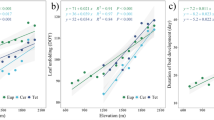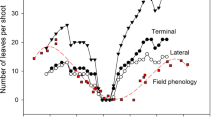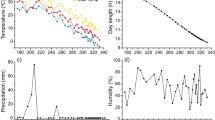Abstract
Key message
Autumn phenology and physiology in the subtropical tree species Torreya grandis and in a subtropical provenance of Carya illinoinensis are affected by air temperature rather than photoperiod.
Abstract
Though leaf phenology is a key tree trait affecting several ecological processes in forested ecosystems, its environmental and genetic regulation in subtropical trees is poorly understood. A few recent studies have addressed the spring phenology of subtropical trees, but the regulation of autumn leaf senescence in these trees remains unexplored. Here we carried out an experimental study of the effects of air temperature and photoperiod on autumn phenology and physiology of seedlings of two tree species growing in subtropical southeastern China: the native torreya (Torreya grandis) and a subtropical provenance of the non-native pecan (Carya illinoinensis). Our first-time results, still limited, suggest a major role of air temperature in the degradation of leaf chlorophyll and leaf senescence in the deciduous pecan: low air temperature accelerated and high air temperature delayed these processes. As expected, no leaf senescence and only minor degradation of leaf chlorophyll was observed in the evergreen torreya. In both species, the depth of bud dormancy was increased by high temperatures during dormancy induction. Our results suggest that in torreya, the depth of both endo- and ecodormancy is increased by high temperatures. As predicted by our experimental results from autumn only, an apparent legacy effect of autumn leaf senescence on bud burst in the next spring was found in an analysis of observational phenology data on adult pecan trees growing in southern USA: late leaf senescence in the autumn was followed by a late bud burst the next spring, and vice versa.






Similar content being viewed by others
References
Aikio S, Taulavuori K, Hurskainen S, Taulavuori E, Tuomi J (2019) Contributions of day length, temperature and individual variability on the rate and timing of leaf senescence in the common lilac Syringa vulgaris. Tree Physiol 39:961–970
Baumgarten F, Zohner C, Gessler A, Vitasse Y (2021) Chilled to be forced: the best dose to wake up buds from winter dormancy. New Phytol 230:1366–1377
Bazot S, Barthes L, Blanot D, Fresneau C (2013) Distribution of non-structural nitrogen and carbohydrate compounds in mature oak trees in a temperate forest at four key phenological stages. Trees 27:1023–1034
Chen L, Huang J-G, Ma Q, Hänninen H, Tremblay F, Bergeron Y (2019) Long-term changes in the impacts of global warming on leaf phenology of four temperate tree species. Glob Change Biol 25:997–1004
Chuine I (2010) Why does phenology drive species distribution? Philos Trans R Soc B 365:3149–3160
Chuine I, Morin X, Bugmann H (2010) Warming, photoperiods, and tree phenology. Science 329:277–278
Cooke JEK, Eriksson ME, Junttila O (2012) The dynamic nature of bud dormancy in trees: environmental control and molecular mechanisms. Plant Cell Environ 35:1707–1728
del Rio-Garcia T, Mediavilla S, Silla F, Escudero A (2015) Differences in the environmental control of leaf senescence of four Quercus species coexisting in a Mediterranean environment. Forest Syst 24:e027
Delpierre N, Dufrȇne E, Soudani K, Ulrich E, Cecchini S, Boé J, François S (2009) Modelling interannual and spatial variability of leaf senescence for three deciduous tree species in France. Agric Forest Meteorol 149:938–948
Delpierre N, Guillemot J, Dufrêne E, Cecchini S, Nicolas M (2017) Tree phenological ranks repeat from year to year and correlate with growth in temperate deciduous forests. Agric Forest Meteorol 234:1–10
Du Y, Pan Y, Ma K (2019) Moderate chilling requirement controls budburst for subtropical species in China. Agric Forest Meteorol 278:107693
Fracheboud Y, Luquez V, Björkén L, Sjödin A, Tuominen H, Jansson S (2009) The control of autumn senescence in European Aspen. Plant Physiol 149:1982–1991
Fu YH, Zhao H, Piao S, Peaucelle M, Peng S, Zhou G, Ciais P, Huang M, Menzel A, Peñuelas J, Song Y, Vitasse Y, Zeng Z, Janssens IA (2015) Declining global warming effects on the phenology of spring leaf unfolding. Nature 526:104–107
Fu YH, Piao S, Delpierre N, Hao F, Hänninen H, Liu Y, Sun W, Janssens IA, Campioli M (2018) Larger temperature response of autumn leaf senescence than spring leaf-out phenology. Glob Change Biol 24:2159–2168
Fu YH, Piao S, Zhou X, Geng X, Hao F, Vitasse Y, Janssens IA (2019a) Short photoperiod reduces the temperature sensitivity of leaf-out in saplings of Fagus sylvatica but not in horse chestnut. Glob Change Biol 25:1696–1703
Fu YH, Zhang X, Piao S, Hao F, Geng X, Vitasse Y, Zohner C, Peñuelas J, Janssens IA (2019b) Daylength helps temperate deciduous trees to leaf-out at the optimal time. Glob Change Biol 25:2410–2418
Fuchigami LH, Weiser CJ, Kobayashi K, Timmis R, Gusta LV (1982) A degree growth stage (°GS) model and cold acclimation in temperate woody plants. In: Li PH, Sakai A (eds) Plant cold hardiness and freezing stress. Mechanisms and crop implications, vol 2. Academic Press, New York, pp 93–116
Gill AL, Gallinat AS, Sanders-DeMott R, Rigden AJ, Gianotti DJS, Mantooth JA, Templer PH (2015) Changes in autumn senescence in northern hemisphere deciduous trees: a meta-analysis of autumn phenology studies. Ann Bot 116:875–888
Håbjørg A (1972) Effects of photoperiod and temperature on growth and development of three latitudinal and three altitudinal populations of Betula pubescens Ehrh. Sci Rep Agric Univ Norway 51(2):1–27
Hänninen H (1990) Modelling bud dormancy release in trees from cool and temperate regions. Acta Forestalia Fennica 213:1–47
Hänninen H (2016) Boreal and temperate trees in a changing climate: modelling the ecophysiology of seasonality. Springer Science+Business Media, Dordrecht
Heide OM (2003) High autumn temperature delays spring bud burst in boreal trees, counterbalancing the effect of climatic warning. Tree Physiol 23:931–936
Heide OM, Prestrud AK (2005) Low temperature, but not photoperiod, controls growth cessation and dormancy induction and release in apple and pear. Tree Physiol 25:109–114
Hu Y, Zhang Y, Yu W, Hänninen H, Song L, Du X, Zhang R, Wu J (2018) Novel insights into the influence of seed sarcotesta photosynthesis on accumulation of seed dry matter and oil content in Torreya grandis cv. “Merrillii” Front Plant Sci 8:2179
Jewaria PK, Hänninen H, Li X, Bhalerao RP, Zhang R (2021) A hundred years after: endodormancy and the chilling requirement in subtropical trees. New Phytol 231:565–570
Junttila O, Nilsen J, Igeland B (2003) Effect of temperature on the induction of bud dormancy in ecotypes of Betula pubescens and Betula pendula. Scan J Forest Res 18:208–217
Kalcsits LA, Silim S, Tanino K (2009) Warm temperature accelerates short photoperiod-induced growth cessation and dormancy induction in hybrid poplar (Populus x spp.). Trees 23:971–979
Keenan TF, Richardson AD (2015) The timing of autumn senescence is affected by the timing of spring phenology: implications for predictive models. Glob Change Biol 21:2634–2641
Keenan TF, Gray J, Friedl MA, Toomey M, Bohrer G, Hollinger DY, Munger JW, O’Keefe J, Schmid HP, SueWing I, Yang B, Richardson AD (2014) Net carbon uptake has increased through warming-induced changes in temperate forest phenology. Nat Clim Change 4:598–604
Körner Ch, Basler D (2010a) Phenology under global warming. Science 327:1461–1462
Körner Ch, Basler D (2010) Response Sci 329:278
Lang GA, Early JD, Martin GC, Darnell RL (1987) Endo-, para-, and ecodormancy: physiological terminology and classification for dormancy research. HortScience 22:371–377
Liang L (2019) A spatially explicit modeling analysis of adaptive variation in temperate tree phenology. Agric Forest Meteorol 266–267:73–86
Lichtenthaler HK (1987) Chlorophylls and carotenoids: Pigments of photosynthetic biomembranes. Methods Enzymol 148 C:350–382
Liu Q, Piao S, Campioli M, Gao M, Fu YH, Wang K, He Y, Li X, Janssens IA (2020) Modeling leaf senescence of deciduous tree species in Europe. Glob Change Biol 26:4104–4118
Marchand LJ, Dox I, Gričar J, Prislan P, Leys S, Van den Bulcke J, Fonti P, Lange H, Matthysen E, Peñuelas J, Zuccarini P, Campioli M (2020) Inter-individual variability in spring phenology of temperate deciduous trees depends on species, tree size and previous year autumn phenology. Agric Forest Meteorol 290:108031
Menzel A, Fabian P (1999) Growing season extended in Europe. Nature 397:659
Menzel A, Sparks TH, Estrella N, Koch E, Aasa A, Ahas R, Alm-Kübler K, Bissolli P, Braslavská O, Briede A, Chmielewski FM, Crepinsek Z, Curnel Y, Dahl Ã, Defila C, Donnelly A, Filella Y, Jatczak K, Måke F, Mestre A, Nordli Ø, Peñuelas J, Pirinen P, Remišová V, Scheifinger H, Striz M, Susnik A, van Lieth AJH, Wielgolaski F-E, Zach S, Zust A (2006) European phenological response to climate change matches the warming pattern. Glob Change Biol 12:1969–1976
Pan Y-q, Zeng X, Chen W-d, Tang X-r, Dai K, Du Y-j, Song X-q (2021) Chilling rather than photoperiod controls budburst for gymnosperm species in subtropical China. J Plant Ecol. https://doi.org/10.1093/jpe/rtab076
Peñuelas J, Filella I (2001) Responses to a warming world. Science 294:793–795
Perry TO (1971) Dormancy of trees in winter. Science 171:2936
Richardson AD, Hollinger DY, Dail DB, Lee JT, Munger JW, O’Keefe J (2009) Influence of spring phenology on seasonal and annual carbon balance in two contrasting New England forests. Tree Physiol 29:321–331
Roxas AA, Orozco J, Guzmán-Delgado P, Zwieniecki MA (2021) Spring phenology is affected by fall non-structural carbohydrate concentration and winter sugar redistribution in three Mediterranean nut tree species. Tree Physiol 41:1425–1438
Sarvas R (1972) Investigations on the annual cycle of development of forest trees. Active period. Communicationes Instituti Forestalis Fenniae 76(3):1–110
Sarvas R (1974) Investigations on the annual cycle of development of forest trees. II. Autumn dormancy and winter dormancy. Communicationes Instituti Forestalis Fenniae 84(1):1–101
Søgaard G, Johnsen Ø, Nilsen J, Junttila O (2008) Climatic control of bud burst in young seedlings of nine provenances of Norway spruce. Tree Physiol 28:311–320
Song Z, Song X, Pan Y, Dai K, Shou J, Chen Q, Huang J, Tang X, Huang Z, Du Y (2020) Effects of winter chilling and photoperiod on leaf-out and flowering in a subtropical evergreen broadleaved forest in China. Forest Ecol Manag 458:117766
Sparks D (1993) Chilling and heating model for pecan budbreak. J Am Soc Hort Sci 118:29–35
Sparks D (1995) Adaptability of pecan as a species. HortScience 40(5):1175–1189
Volk GM, Waddell J, Towill L (2009) Variation in low-temperature exotherms of pecan cultivat dormant twigs. HortScience 44:317–321
Way DA, Montgomery RA (2015) Photoperiod constraints on tree phenology, performance and migration in a warming world. Plant Cell Environ 38:725–1736
Westergaard L, Eriksen EN (1997) Autumn temperature affects the induction of dormancy in first-year seedlings of Acer platanoides L. Scan J Forest Res 12:11–16
Zani D, Crowther TW, Mo L, Renner SS, Zohner CM (2020) Increased growing-season productivity drives earlier autumn leaf senescence in temperate trees. Science 370:1066–1071
Zhang R, Peng F, Li Y (2015) Pecan production in China. Scientia Horticult 197:719–727
Zhang R, Lin J, Wang F, Shen S, Wang X, Rao Y, Wu J, Hänninen H (2021a) The chilling requirement of subtropical trees is fulfilled by high temperatures: A generalized hypothesis for tree endodormancy release and a method for testing it. Agric Forest Meteorol 298–299:108296
Zhang R, Wang F, Zheng J, Lin J, Hänninen H, Wu J (2021b) Chilling accumulation and photoperiod regulate rest break and bud burst in five subtropical tree species. Forest Ecol Manag 485:118813
Acknowledgements
We thank Pekka Hirvonen (www.toisinsanoen.eu) for revising the language of the manuscript.
Funding
This study was financially supported by the Chinese National Natural Science Foundation (31800579), the National Forestry and Grassland Technological Innovation Program for Young TopNotch Talents [2020132604], the Key Research Program of Zhejiang Province (2018C02004) and the Overseas Expertise Introduction Project for Discipline Innovation (111 Project D18008).
Author information
Authors and Affiliations
Corresponding authors
Ethics declarations
Conflict of interest
The authors declare that they have no conflict of interest.
Additional information
Communicated by L. Kalcsits.
Publisher’s Note
Springer Nature remains neutral with regard to jurisdictional claims in published maps and institutional affiliations.
Electronic Supplementary Material
Below is the link to the electronic supplementary material.
Rights and permissions
About this article
Cite this article
Wang, F., Zhang, R., Lin, J. et al. High autumn temperatures increase the depth of bud dormancy in the subtropical Torreya grandis and Carya illinoinensis and delay leaf senescence in the deciduous Carya. Trees 36, 1053–1065 (2022). https://doi.org/10.1007/s00468-022-02272-6
Received:
Accepted:
Published:
Issue Date:
DOI: https://doi.org/10.1007/s00468-022-02272-6




